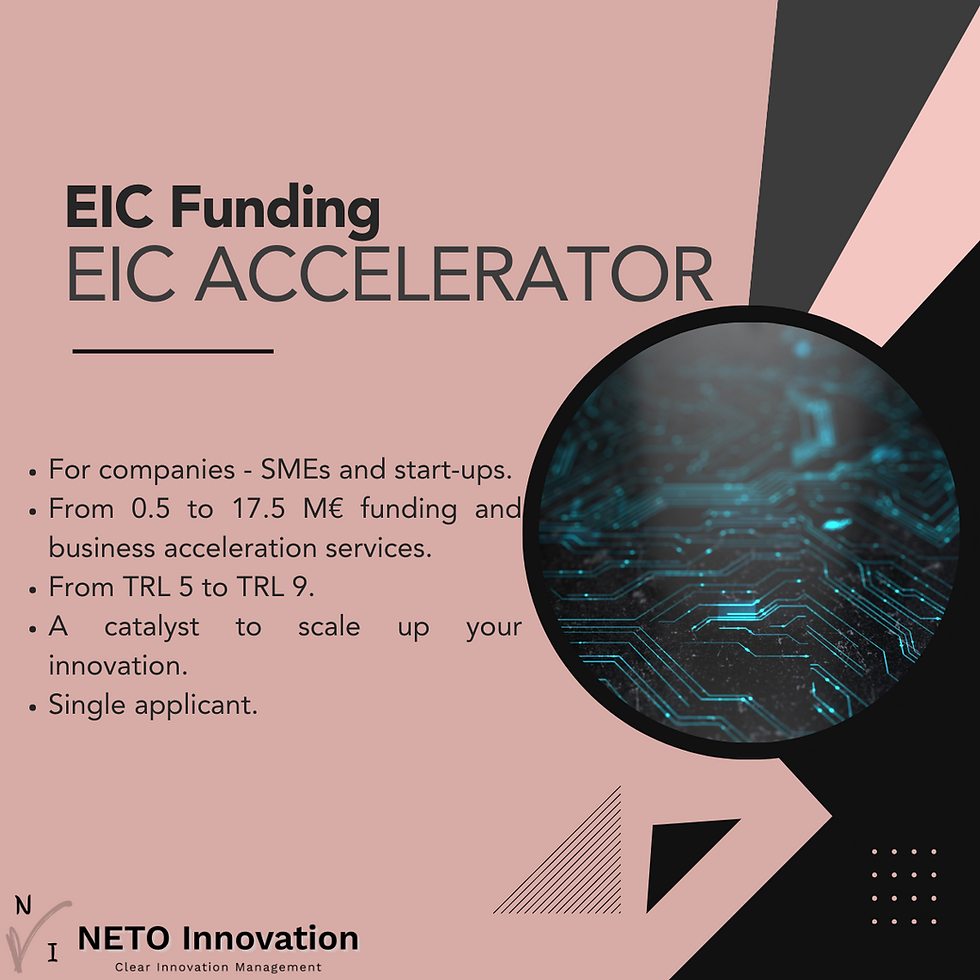Guide to the EIC Pathfinder Challenges 2024
- Stéphanie

- Mar 11, 2024
- 5 min read
The European Innovation Council (EIC) was introduced by the European Commission to support the commercialization of high-risk, high-impact technologies in the European Union. Launched in March 2021 under the Horizon Europe program, it emerged from a pilot phase that began in 2018, incorporating existing instruments under the Horizon 2020 program, such as the SME instrument and Future & Emerging Technology (FET) program. The EIC plays a pivotal role in helping researchers, startups, and SMEs to bring their innovations to market by providing funding, networking opportunities, and business acceleration services.
3 funding schemes adapted to your TRL: EIC Pathfinder, EIC Transition and EIC Accelerator
The European Innovation Council (EIC) structures its funding and support into three principal schemes. The EIC Pathfinder encourages advanced research to establish the groundwork for breakthrough technologies. Complementing this, the EIC Transition focuses on validating these technologies and crafting business models for their application. For more market-oriented goals, the EIC Accelerator supports companies, including SMEs, startups, and spin-offs, in commercializing and scaling their innovations. Two types of schemes are available within the EIC Pathfinder and Accelerator: "Open" calls for all technology fields, and targeted "Challenges" calls for strategically important areas. In this article, we will focus on the EIC Pathfinder Challenges.
In 2024, the EIC Pathfinder proposes to fund 5 challenges in specific areas:
1. Solar-to-X devices for the decentralized presumption of renewable fuels, chemicals and materials as climate change mitigation pathway
This challenge addresses solar-to-X technologies, also called artificial photosynthesis or solar fuel technologies, which directly convert solar energy into synthetic fuels and chemicals. This challenge includes i) Novel electrolyzer designs showing a significantly simplified balance-of-plant compared to mature electrolyzer designs; ii) Fully-integrated PV-EC devices, with electrochemical conversion (EC) and photovoltaic unit (PV) combined in a single device; iii) Photosynthetic devices converting directly sunlight and simple feedstock molecules into a fuel or chemical (e.g., Photoelectrochemical devices, Particulate systems, Biohybrid photosynthetic devices, Thermally-integrated photosynthetic devices, etc.); iv) Solar-driven biological conversion devices (e.g., solar cell factories).
The proposals should address one of the following areas:
Area 1: Standalone solar-to-X device development.
Area 2: Benchmarking and common metrics development for solar-to-X devices.
Area 3: Understanding fundamental mechanisms by means of computational materials science.
2. Towards cement and concrete as a carbon sink
The scope of this challenge is to support the development of breakthrough innovations for decarbonized and carbon-negative cement and concrete. The focus is on finding viable, cost-effective, and efficient alternatives to current mainstream technologies in the cement and concrete industries. Specific domains are targeted:
Development of alternative low-carbon binder technologies using different feedstocks and curing processes.
Efficient use of clinker in cement and cement in concrete to reduce the overall carbon footprint.
Technologies to lower or eliminate the need for burning fossil fuels in the manufacturing process.
Supporting technologies based on computational material science or data-driven science, including AI and ML, to enhance the understanding and development of cementitious materials.

3. Nature inspired alternatives for food packaging and films for agriculture
This challenge aims at developing sustainable alternatives to fossil fuel-derived plastics used in food production and packaging. It focuses on creating nature-inspired materials for applications such as greenhouse and mulch films, ensuring they are environmentally friendly, functionally equivalent to plastics, and have a reduced impact through their lifecycle. The challenge encourages the use of abundant, natural materials optimized for food-related applications, emphasizing sustainability, reusability, recycling, and biodegradability, including in extreme environments.
4. Nanoelectronics for energy-efficient smart edge devices
This challenge is addressing the critical issues of power consumption and heat dissipation in electronics, from mobile devices to data centers, particularly in smart edge devices. The objective is to develop solutions that significantly reduce power consumption in smart edge devices, particularly in edge processing, sensing, imaging, communication, and power management. Key aspects include addressing fundamental issues like heat dissipation at the nanoscale, which is crucial in information processing, and demonstrating the potential of these technologies for energy savings and reduced environmental impact. The projects will explore material and process solutions to overcome the "heat valley" in device design.
5. Strengthening the sustainability and resilience of EU space infrastructure
This challenge addresses the critical issue of increasing space debris and its impact on space infrastructure. The focus is on developing innovative solutions for debris mitigation, active removal, and in-space recycling of orbital assets. The goals include creating technologies for controlled debris mitigation and removal, recycling dysfunctional orbital assets, and protecting EU space infrastructure. Breakthrough concepts in areas such as propellantless propulsion and recycling in space are expected. These innovations aim to enhance the sustainability and safety of space operations, contributing to EU strategic autonomy and space policy.
Budget, timeline and eligibility criteria
The total budget for EIC Pathfinder Challenge is 120M€, expected to be evenly distributed across various challenges. Each project can receive up to 4M€ in EU contributions, though larger amounts can be requested if justified. The funding will cover 100% of eligible costs, determined as a lump sum during the evaluation process based on estimated project costs.
The call deadline for submitting a proposal is 16 October 2024.
Funding proposals may include collaborative or individual research. To be eligible to EIC Pathfinder Challenges, consortia or single entities must be Member States or Associated Countries. Consortia must have independent entities from different countries, with specific composition requirements based on the number of entities.
How can NETO Innovation support you?
As a result of our large network and project writing expertise, we can assist you with:
Finding the right partners in the participating countries. NETO Innovation has access to a wide range of partners, both private and public. Our team has the necessary skills and experience to match you with the best possible partners for your project. We can also ensure that the project is written in a way that meets your specific requirements and specifications.
Supporting you in writing the project application. Our team has experience in writing for a variety of partners, across different sectors and disciplines. We are familiar with the requirements of various funding bodies and can provide you advice on how to make your project application stand out from the rest. We also have experience in writing for a range of audiences, so you can be sure that your project application is written with clarity and precision.
Fill in the online application and submit the proposal. With NETO Innovation’s team you can be assured that your project application is clear, concise, compelling, and submitted on time.
Interested in the EIC Pathfinder Challenges call? Does writing grant applications seem overwhelming to you? Feel free to contact the NETO Innovation team to find out how we can support you and ease your innovation funding process. We can also provide you with more information about the possible budgets, selection criteria, and evaluation process. So, hurry up and contact our team here.
Don't miss out on our latest insights and updates. Subscribe to NETO Innovation's newsletter and follow us on our social media channels for more informative content about the EIC Accelerator and other funding schemes.





Comments